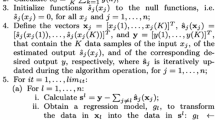Abstract
Three new learning algorithms for Takagi-Sugeno-Kang fuzzy system based on training error and genetic algorithm are proposed. The first two algorithms are consisted of two phases. In the first phase, the initial structure of neuro-fuzzy network is created by estimating the optimum points of training data in input-output space using KNN (for the first algorithm) and Mean-Shift methods (for the second algorithm) and keeps adding new neurons based on an error-based algorithm. Then in the second phase, redundant neurons are recognized and removed using a genetic algorithm. The third algorithm then builds the network in one phase using a modified version of error algorithm used in the first two methods. The KNN method is shown to be invariant to parameter K in KNN algorithm and in two simulated examples outperforms other neuro-fuzzy approaches in both performance and network compactness.
Similar content being viewed by others
Explore related subjects
Discover the latest articles, news and stories from top researchers in related subjects.References
Buckley JJ, Hayashi Y (1994) Fuzzy neural networks: A survey. Fuzzy Sets Syst 1–13
Buckley JJ, Hayashi Y (1995) Neural networks for fuzzy systems. Fuzzy Sets Syst 265–276
Bunke H, Kandel A (2000) Neuro-fuzzy pattern recognition. World Scientific, Singapore
Chuang C, Su S, Chen S (2001) Robust TSK fuzzy modeling for function approximation with outliers. IEEE Trans Fuzzy Syst 9
Comaniciu D, Meer P (1997) A robust analysis of feature spaces: color image segmentation. In: Proc 1997 IEEE conf computer vision and pattern recognition, pp 750–755
Dickerson JA, Kosko B (1996) Fuzzy function approximation with ellipsoidal rules. IEEE Trans Syst Man Cybern 26(4):542–560
Er MJ, Wu S (2002) A fast learning algorithm for parsimonious fuzzy neural systems. Fuzzy Sets Syst 337–351
Fukunaga K, Hostetler LD (2002) The estimation of the gradient of a density function, with applications in pattern recognition. IEEE Trans Pattern Anal Mach Intell 24:603–619
Gonzalez J, Rojas I, Pomares H, Ortega J, Prieto A (2002) New clustering technique for function approximation. IEEE Trans Neural Netw 13:132–152
Jang JSR (1993) ANFIS: adaptive-network-based fuzzy inference system. IEEE Trans Syst, Man Cybern 665–684
Khayat, et al (2009) A novel hybrid algorithm for creating self-organizing fuzzy neural networks. Neurocomputing
Klawonn F, Keller A (1998) Grid clustering for generating fuzzy rules. In: European congress on intelligent techniques and soft computing, Aachen, Germany, pp 1365–1369
Klawonn F, Kruse R (1997) Constructing a fuzzy controller from data. Fuzzy Sets Syst 85:177–193
Kosko B (1994) Fuzzy systems as universal approximators. IEEE Trans Comput 43:1329–1333
Kroll A (1996) Identification of functional fuzzy models using multi-dimensional reference fuzzy sets. Fuzzy Sets Syst 80:149–158
Kulkarni AD, Cavanaugh CD (2000) Fuzzy neural network models for classification. Appl Intell 12:207–215. doi:10.1023/A:1008367007808
Leng G, McGinnity T (2006) Design for self organizing fuzzy neural network based on genetic algorithm. IEEE Trans Fuzzy Syst
Leng G, Prasad G, McGinnity, TM (2006) An on-line algorithm for creating self-organizing fuzzy neural networks. Neural Netw 19:974
Lin S-F, Chang J-W, Hsu Y-C (2010) A self-organization mining based hybrid evolution learning for TSK-type fuzzy model design. Appl Intell, December
Nauck D, Kruse R (1997) Function approximation by NEFPROX. In: Proc second European workshop on fuzzy decision analysis and neural networks for management, planning, and optimization, Dortmund, pp 160–169
Nauck D, Kruse R (1999) Neuro-fuzzy systems for function approximation. Fuzzy Sets Syst 101:261–271
Park B-J, Pedrycz W, Oh S-K (2008) Polynomial-based radial basis function neural networks (P-RBF NNs) and their application to pattern classification. Appl Intell 32(1):27–46
Pedrycz W (1996) Fuzzy modeling: paradigms and practice. Springer, Berlin, p 205
Schilling RJ, Carroll JJ, Al-Ajlouni AF (2001) Approximation of nonlinear systems with radial basis function neural networks. IEEE Trans Neural Netw 1–15
Takagi T, Sugeno M (1995) Fuzzy identification of systems and its applications to modeling and control. IEEE Trans Syst Man Cybern 15:116–132
Wang JS, Lee CSG (2001) Efficient neuro-fuzzy control systems for autonomous underwater vehicle control. In: IEEE international conference on robotics and automation, pp 2986–2991
Wang L-X (1997) A Course in fuzzy systems and control. Prentice-Hall, New York
Wu S, Er MJ (2000) Dynamic fuzzy neural networks-a novel approach to function approximation. IEEE Trans Syst, Man Cybern 358–364
Wu S, Er MJ, Gao Y (2001) A fast approach for automatic generation of fuzzy rules by generalized dynamic fuzzy neural networks. IEEE Trans Fuzzy Syst 578–594
Author information
Authors and Affiliations
Corresponding author
Rights and permissions
About this article
Cite this article
Malek, H., Ebadzadeh, M.M. & Rahmati, M. Three new fuzzy neural networks learning algorithms based on clustering, training error and genetic algorithm. Appl Intell 37, 280–289 (2012). https://doi.org/10.1007/s10489-011-0327-7
Published:
Issue Date:
DOI: https://doi.org/10.1007/s10489-011-0327-7




